Thinking is the mental activity of a person, which allows one to judge surrounding things, phenomena, situations; solve simple and complex problems; cope with problems and difficulties that arise throughout life.
The following features of thinking are distinguished:
- mediation, that is, a person can cognize an object or phenomenon not directly, but indirectly (indirectly): from the unknown to the known, through one properties to others;
- generality, that is, the ability to combine objects according to some characteristics.
Human mental activity is formed by special tools and mental processes:
- analysis (isolating individual properties, features from the whole);
- synthesis (establishing semantic connections between objects or phenomena);
- comparison (differences or similarities of objects, phenomena with each other);
- generalization (combining various phenomena or objects into groups based on a common feature);
- specification (return from the general to the specific);
- abstraction (identification of one main of many common features);
- analogy (transfer of knowledge about a studied subject to an unstudied or inaccessible for study).
Every person uses all these operations, consciously or unconsciously, throughout his life. But how effective is our thinking? Everything depends on the quality of a person’s upbringing from birth: on the formation of the first visual-effective thinking and the enrichment of subsequent visual-figurative thinking.
Visual form of thinking in preschool age
In psychology, several forms of thinking are distinguished, most of which are formed in adulthood.
Before entering school, children go through the following mental stages:
- clearly effective;
- visually figurative;
- verbal logical thinking.
In the future, the formation of intuitive, analytical and empirical forms continues.
Visual types of thinking are most important for preschool age. It is the successful passage through these stages that provides the future adult with the ability to form judgments about events and draw conclusions.
Clearly effective
Visually effective thinking is fully formed by the age of 3. Starting from the age of one and a half, boys and girls “think” with their hands.
The main features of visually effective thinking are the use of one’s own fingers as a tool of cognition.
Connecting broken halves, breaking or disassembling a toy - all this is a way of primary perception of objects and an opportunity to understand what surrounds a little person. That is why this type of cognition is called visually effective. Mastering an action—for example, stacking cubes into something similar to a structure—occurs after several successful attempts to assemble a turret or house.
Visually figurative
From about 3 years old, a new type of thinking begins to form: in addition to studying the world with one’s hands, a system of images imprinted in memory is added.
This means that the baby can visually reproduce an already familiar object, information about which has settled in memory. The skill of using an image is especially evident during drawing or sculpting.
Detailed image accuracy should not be expected at this age. The preschooler draws exactly those features that, in his opinion, characterize this or that object. The tree will have a trunk and branches. The house must be equipped with a roof and walls.
During this period, it is especially important for parents to encourage their child to engage in any activities related to visualization.
It could be:
- applique made of colored and shiny paper;
- games with constructors;
- drawing with pencils, crayons, paints;
- modeling from clay and plasticine.
Description of types of thinking according to the method of J. Bruner
So, you took the test and found out what type of thinking prevails in you. Below you can find a description of each type.
Subject thinking
Subject thinking involves accepting information sequentially, when a complex operation is broken down into a chain of simpler ones. This kind of thinking is typical for people with a practical mindset.
They do not like long discussions and fantasies; they immediately get down to business and bring it to the end. They seek and find benefits from every action. Quickly adapt to changes.
And, in fact, they develop well in all areas of activity, especially if they set such a goal for themselves. It is believed that this mentality is characteristic of men.
Symbolic thinking
Symbolic thinking is characteristic of people with a mathematical mindset. The result of mental activity is a clearly structured chain of actions with cause-and-effect relationships.
It is important for such people to understand why it happened this way and not another. They try to get to the bottom of the truth, even if they don’t like the result. They say about such people - a person with an analytical mindset, for whom reason and calculation come first, not emotions.
They are stubborn and independent. Such people are little susceptible to criticism. Such people often have highly developed intuition, which means predicting future events based on past experience and conclusions drawn from this. They are characterized by such areas of activity as science, business, politics, and organizational activities.
Sign thinking
Iconic thinking is characteristic of people with a humanitarian mindset. Such thinking implies the rapid assimilation of a large amount of information due to its transformation from signs and bright fragments into a large unit. It is easier for such people to assimilate information when visual memory is involved.
Such people rarely try to understand the essence; the very fact of what happened is important to them. They are receptive and vulnerable, emotional. People with symbolic thinking give preference to such disciplines as history, literature and art, both artistic and other areas. And also jurisprudence, law.
Creative thinking
Imaginative thinking is inherent in people with an artistic mindset. This is a non-standard type of thinking. Such people like to convey information through images rather than words, which confuses their interlocutors. During conversations, they often use adjectives and comparative phrases.
Such people love to fantasize and dream. They are very susceptible to criticism and react sharply to the events they experience. Such people are most often found among representatives of creative professions.
How visually effective thinking develops in preschoolers
Supporting the development of visually effective and imaginative thinking in preschoolers is simple: the key goal of parents is not to interfere with the dismantling or “modernization” of objects. The only limitation is security measures. Materials should be as harmless as possible for younger preschoolers.
Object actions do not immediately lead the child to understand the main features and purpose of the object. It takes time and repeated manipulations for the child’s mind to grasp visual generalizations and build the necessary connections.
For example, if a preschooler made his first attempts to draw with a pencil, then when he sees colored crayons he will not imagine their purpose without preliminary tests.
It is especially effective to form the memory of images with the help of flowing and bulk materials. The child pours sand from hand to hand, makes slides from cereals, and pours water. Constant touching allows him to first determine and then remember that if the sand is properly crushed, it will turn out to be a Easter cake.
To summarize what has been said, the basic principle of the development of this form of thought process is expressed in repeated actions leading to the same result: a picture, an assembled toy, a sculpted figurine.
This is how the first ideas about specific objects and life experience arise, which lay the foundation for the development of mental forms.
Diagnostic methods and research methods
Diagnostic methods are available for all ages using a variety of techniques. Methods for children of primary school age:
- “Elimination of the superfluous” Purpose: studying the ability to generalize.
- “Simple analogies” Purpose: to study the flexibility of thinking.
- “Nonsense” Purpose: assessment of figurative ideas and the ability to build logical connections.
- The “Identification of Essential Features” technique is used to work with adolescents and adults. Purpose: to study the ability to identify main features and distinguish them from secondary ones.
- A common technique for children and adults is J. Raven’s Matrices. Goal: Studying the logic of thinking.
Formation of visually imaginative thinking
The basis of visual figurative thinking is a guess about a possible result. Before taking an action, the child imagines the end result. For example, sitting at home, a preschooler is able to draw a picture of a car, remembering the one he liked on the street.
The first rudiments appear at 3 years. To evaluate the result, tactile perception, which implies contact with the object, is no longer always necessary. The image in the head helps to correlate the object seen with an already known category and correctly evaluate it. A preschooler can easily recognize a doll or teddy bear on a display window without having to touch it first.
The greater the number of objects that are remembered, the less often tactile contact will be required for identification, but the connections and relationships between the image and the real object will be realized.
What is it: definition of the concept in psychology
Imaginative thinking is called so because its essence consists in operating with images: it helps to collect all the information about an object or phenomenon that was received from the surrounding world through the senses, forms an overall picture and produces it in the form of a mental image.
Operating with images is characteristic of cognition and is a mandatory component of it. It is characterized by a generalized and indirect reflection of reality, modeling patterns based on existing knowledge.
Why is it important to develop creative thinking?
The very concept of “image” means the imprinting of objects and phenomena of the real world in human consciousness, the formation of an imaginary appearance.
A preschooler, especially an older one, is already able to accumulate a sufficient number of such reflections. Moreover, sometimes they are not visual, but tactile or audio in nature.
The skill of imaginative thinking greatly simplifies a child’s interaction with the outside world. To solve a given problem, he just needs to imagine all its components and find the answer.
In the future, properly developed imaginative thinking will make it easier to master spatial thinking and imagine the world in three-dimensional display.
It is especially important to pay attention to the child at the stage of development of imaginative thinking for the following reasons:
- The ability to operate with images significantly speeds up the solution of first everyday, and later logical and mathematical problems.
- The ability to think in images forms the aesthetic component of the personality and the craving for beauty, which intensifies as one grows older.
- Operating with images contributes to the development of creative thinking.
In adults
In adulthood, imaginative thinking is based on acquired knowledge and rich personal experience.
What is it for: functions
A person quickly collects all available information on a task in his head and imagines the expected outcome in the form of a picture and emotions. For a person who thinks in pictures:
- makes memorization easier;
- perception of text, television films;
- intuition develops.
Imaginative thinking saves effort, time and money, helping to visualize the result mentally and evaluate it.
Ways to develop visually imaginative thinking
Depending on the age and preferences of the child himself, various methods are chosen, however, each is based on creating a result based on the presented image.
At the age of three, this is a game with a pyramid and similar collapsible toys. To begin with, the adult shows the process of disassembling and correctly assembling the toy, after which the child is asked to repeat the steps.
To complicate the task, you will need a pyramid with rings of various sizes. An additional effect of the toy is learning to highlight the essential properties of objects, distinguish between sizes, shapes, and shades. It can be stated that the process of developing imaginative thinking has begun when, before an action, the child is able to tell what he will now build or draw.
Basic methods applicable in older preschool age
In the future, the imaginative thinking of older preschoolers should be stimulated using the following methods and techniques:
- observation of nature with subsequent descriptions and displays of what was seen;
- comparative analysis of objects of various sizes and shapes;
- collecting puzzles with gradual complication of the task;
- drawing from memory;
- creative work with plastic materials - modeling from clay, plasticine;
- excursions to museums and exhibitions;
- displaying on paper or canvas concepts that do not have visual signs: love, friendship, thought, sound, melody;
- creating panels using natural materials, cardboard, colored paper.
The effectiveness of classes aimed at developing visual imaginative thinking in preschool age depends on the correct implementation of the stages of learning:
- demonstration;
- description or explanation;
- Team work;
- independent work according to the model;
- creativity based on a generalization of ideas about a phenomenon, not limited by any framework.
Any activity should not tire the child. As soon as he feels tired, he needs to switch his attention to another activity. In addition, it is important to constantly encourage and motivate the child, cultivating in him a true passion for the process of drawing or constructive creativity.
Types of thinking
According to the degree of deployment they are distinguished:
Discursive thinking is analytical thinking based on the logic of reasoning.
Intuitive thinking is based on direct sensory perceptions and direct reflection of the influences of objects and phenomena of the surrounding world.
By nature they distinguish:
Theoretical thinking is thinking based on theoretical reasoning and conclusions, this is the knowledge of laws and rules.
Practical thinking is reasoning when solving practical problems, its goal is to develop means of practical transformation of reality: setting a goal, creating a plan, project, scheme.
Theoretical thinking, in turn, is divided into conceptual and figurative.
Conceptual thinking is thinking that uses certain concepts. Conceptual thinking provides the most accurate and generalized reflection of reality, but this reflection is abstract.
Figurative thinking is a type of thought process that uses images . These images are extracted directly from memory or recreated by imagination. Imaginative thinking allows us to obtain a specific subjective reflection of the reality around us.
Based on their form, such types of thinking are distinguished as visual-effective, visual-figurative and abstract-logical (verbal-logical); these types of thinking can also be considered as levels of its development.
Visual-effective (pre-conceptual) thinking is a special type of thinking, the essence of which is that the solution to a problem is carried out with the help of practical transformative activities carried out with real objects. This form of thinking is dominant in early childhood.
Visual-figurative thinking is a type of thinking in which the solution to a problem is carried out using operations with images that arise in the immediate situation. The necessary images are represented in short-term and operative memory. This form of thinking is dominant in children of preschool and primary school age.
Verbal-logical thinking is a type of thinking in which the solution of a problem is carried out using operations with concepts. It is dominant starting from adolescence.
Abstract-logical is a more complex type of thinking, based on identifying the essential properties and connections of an object and abstracting from the unimportant.
Each of these types of thinking develops independently. Theoretical thinking is considered more perfect than practical thinking, and conceptual thinking represents a higher level of development than figurative thinking.
According to the degree of novelty and originality, they are distinguished:
Reproductive thinking is based on the assimilation and operation of ready-made concepts, judgments, patterns and their application in a certain situation.
Productive thinking is thinking that creates something new for the subject. The thinking process consists of finding a means to solve a problem, taking into account existing conditions. It lies at the heart of creativity.
The functions are distinguished:
Critical thinking – aims to identify deficiencies in judgment.
Creative – associated with the discovery of fundamentally new knowledge.
Basic forms of thinking
1. A concept is a reflection of the general and essential properties of objects or phenomena. Types of concepts:
q General concepts - cover a whole class of homogeneous objects or phenomena that bear the same name. For example, the concepts of “chair”, “building”, “disease”, “person”, etc. General concepts reflect the characteristics characteristic of all objects that are united by the corresponding concept.
q Single concepts – denote any one subject. For example, “Yenisei”, “Venus”, “Saratov”, etc. Single concepts represent a body of knowledge about any one subject, but at the same time they reflect properties that can be covered by another, more general concept. For example, the concept of “Yenisei” includes the fact that it is a river that flows through the territory of Russia.
2. Judgment is a form of thinking in the process of which connections between objects of reality are affirmed or denied. For example, “This table is brown”, “Metals expand when heated” - expresses the connection between changes in temperature and the volume of metals.
Judgments can be true (objectively true) and false (not corresponding to objective reality); general (when something is stated regarding all subjects in a group, for example: “All students take exams during the session”), specific (for example: “Some students are excellent students”) and individual (for example, “This student did not prepare well for the seminar.” )
Judgment is based on the subject’s understanding of the variety of connections between a particular object or phenomenon and other objects or phenomena. Understanding is the ability to comprehend the meaning and meaning of something. The concepts of “judgment” and “understanding” are not completely identical, but they are closely related to each other. If understanding is an ability, then judgment is the result of this ability.
3. Inference is the highest form of thinking and represents the derivation of a new judgment from one or more judgments. The initial judgments from which the conclusion is drawn are called premises.
Conclusions can be:
q Inductive - reasoning proceeds from individual factors to a general conclusion.
q Deductive - reasoning proceeds from general factors to specific conclusions.
q By analogy - a conclusion is made on the basis of partial similarities between phenomena. For example: it is light during the day and dark at night.
Inference as a form of thinking is based on concepts and judgments and is most often used in the processes of theoretical thinking.
The word “ intelligence ” comes from the Latin intellectus, translated into Russian meaning “understanding”, “understanding”, “comprehension”. Today there are two main interpretations of intelligence: a broader one and a narrower one. In a broader sense, intelligence is a global integral biopsychic feature of a person that characterizes his ability to adapt. Another interpretation of intelligence, a narrower one, combines in this concept a generalized characteristic of a person’s mental abilities.
Main types of mental operations
The main types of mental operations include: comparison, analysis and synthesis, abstraction and concretization, induction and deduction.
Analysis is the mental dissection of something into parts or the mental isolation of individual properties of an object.
The essence of this operation is that, perceiving any object or phenomenon, we can mentally isolate one part of it from another, and then select the next part, etc. In this way we can find out what parts it consists of. what we perceive. Consequently, analysis allows us to decompose the whole into parts, that is, it allows us to understand the structure of what we perceive.
Synthesis is a mental combination of parts of objects or phenomena into one whole, as well as a mental combination of their individual properties.
Being essentially opposite operations, analysis and synthesis are actually closely related to each other. They are involved in every complex thought process. For example, when you, knowing English poorly, hear a conversation in this language, you try first of all to identify familiar words in the spoken phrase, and only then perceive less familiar words and then try to comprehend them. This is where the functions of analysis come into play. However, at the same time, you are trying to put together the meaning of the words you heard and compose a meaningful phrase. In this case, you use another mental operation - synthesis.
Abstraction is a mental abstraction from any parts or properties of an object to highlight its essential features. Abstraction is widely used by us in the formation and assimilation of new concepts, since concepts reflect only essential features common to a whole class of objects. For example, when we say “table,” we represent a certain image of a whole class of objects. This concept unites our ideas about different tables. In order to form this concept, we had to abstract from a number of private properties and characteristics that are characteristic only of a certain object or a separate group of objects that are defined by the concept we formed.
Generalization is the combination of similar objects based on common characteristics. Any concept that people use is a generalization.
Concretization is a process opposite to abstraction; it is the representation of something individual that corresponds to a particular concept or general position. Essentially, specification always acts as an example or as an illustration of something general.
Comparison is the operation of establishing similarities and differences between objects and phenomena of the real world. Recognition of similarity or difference between objects depends on what properties of the objects being compared are essential for us. The success of the comparison depends on how well the indicators for comparison are chosen.
Classification is a derivative of comparison; it is a more complex operation of establishing the similarities and differences between the main and secondary characteristics of objects and phenomena. Thanks to this, it is further possible, based on the similarity of the main characteristics, to unite objects into related groups: species, genera, classes, etc.
Induction is an inference that represents a transition from particular cases to a general position.
Deduction is an inference that represents a transition from the general to the specific.
Solving complex mental problems and creative thinking
The thinking process begins with a problem situation that needs to be solved, and, consequently, with the formulation of a question that arises every time we do not understand something.
To solve a complex mental problem, you need to skillfully choose ways to solve the question posed. In some cases, we have no difficulty in solving a particular mental problem or practical problem. But it often happens that we do not have the necessary knowledge or information to answer the question posed. Therefore, to solve a complex mental problem, a person must be able to find the necessary information, without which it is impossible to solve the main task or problem. In this case, a person, using the capabilities of his thinking, first answers intermediate questions and only then solves the main question. Gradually supplementing the missing information, we come to a solution to the main problem or question that interests us.
When we do not have the information necessary to solve a problem, we usually make an assumption. An assumption is a conclusion that is based on indirect information and our guesses, when we do not have all the knowledge or sufficient information necessary to correctly solve a mental problem.
Practice is the most objective evidence of the truth of conclusions. A significant role in solving complex intellectual problems is played by the skillful use of various techniques. Thus, when solving problems, we often use visual images. Another example is the use of typical techniques in solving typical problems.
In a detailed thought process, several stages or phases can be distinguished:
1. Awareness of the problem situation.
2. Distinguishing what is known and what is not known. As a result, the problem turns into a task.
3. Limitation of the search area.
4. Constructing a hypothesis as an assumption about ways to solve problems.
5. Implementation of the hypothesis.
6. Hypothesis testing. If the test confirms the hypothesis, the solution is implemented.
However, there are times when a person with highly developed thinking tries to solve problems that are not similar to any known ones and do not have a ready-made solution. To solve such problems, we must turn to the possibilities of our creative thinking.
One of the first to attempt to answer the question of what creative thinking is was J. Guilford . In works devoted to creativity (creative thinking), he outlined his concept, according to which the level of development of creativity is determined by the dominance of four features in thinking. Firstly, it is the originality and unusualness of the ideas expressed, the desire for intellectual novelty. A person capable of creativity almost always and everywhere strives to find his own solution.
Secondly, a creative person is distinguished by semantic flexibility , i.e. the ability to see an object from a new angle, the ability to discover the possibility of a new use of a given object.
Thirdly, in creative thinking there is always such a feature as figurative adaptive flexibility , i.e. the ability to change the perception of an object in such a way as to see its new, hidden sides.
Fourthly, a person with creative thinking differs from other people in the ability to produce a variety of ideas in an uncertain situation , in particular in one that does not contain the prerequisites for the formation of new ideas. This ability of creative thinking was called semantic spontaneous flexibility by J. Guilford.
Subsequently, other attempts were made to identify the nature of creativity. These studies identified conditions that promote creative thinking. For example, when faced with a new task, a person strives first of all to use the method or method that was most successful in previous experience. Another equally significant conclusion that was made in the course of research on creative thinking is the conclusion that the more effort was spent on finding a new way to solve a problem, the higher the likelihood that this method will be used to solve another, new mental problem . At the same time, this pattern can lead to the emergence of a thinking stereotype that prevents a person from using new, more appropriate ways to solve a problem. Therefore, in order to overcome stereotypical thinking, a person must completely abandon attempts to solve the problem, and then after a while return to it, but with the firm intention of solving it in a new way.
During the study of creative thinking, another interesting pattern was revealed. Frequent failures in solving mental problems lead to the fact that a person begins to be afraid of meeting each new task, and when faced with a problem, his intellectual abilities are unable to manifest themselves, as they are under the yoke of a person’s lack of faith in his own abilities. For people to demonstrate their intellectual abilities, they need a sense of success and a sense of correctness in completing a particular task.
A number of studies have found that effectiveness in solving mental problems is achieved with appropriate motivation and a certain level of emotional arousal. Moreover, this level is purely individual for each person.
Express test to determine creativity
I bring to your attention another test to determine creativity. Some people think it's funny, others think it's serious.
It is based on the assumption that the left and right hemispheres of the human brain are responsible for different abilities.
- The right hemisphere is creativity, intuition, creativity, feelings, emotions
- Left hemisphere – logic, speech, ability to remember information
This topic has already been raised in the article “Right-hemisphere drawing - secrets, myths, lessons.” Depending on which hemisphere is more developed, those abilities predominate.
In order to find out which hemisphere of the brain is more developed in you, clench your hands into a fist in front of you, as in the picture
If the thumb of the left hand is at the top, the right hemisphere
If the right hand - then the left .
Here's an interesting fact.
| Subscribe to updates from the “Design in Life” blog by email
and we will definitely publish for you even more useful and interesting information from the world of design! |
- Share on Facebook
- Share on Twitter
- Share on Pinterest
- Share on LinkedIn
- Share on Vkontakte
- Share on Instagram









